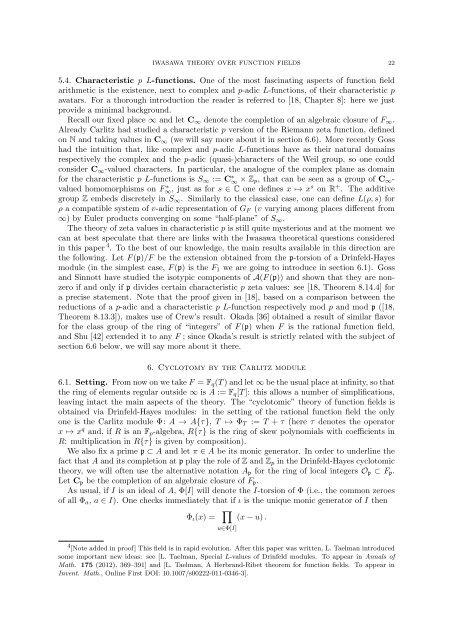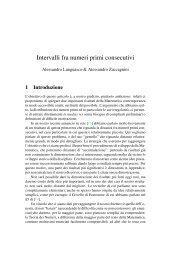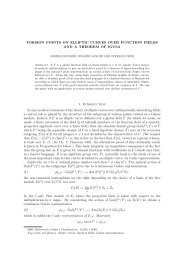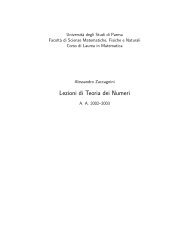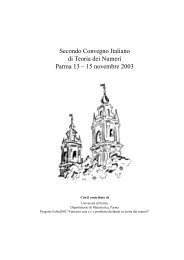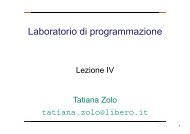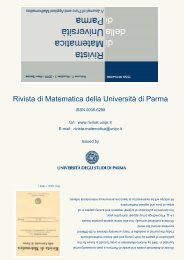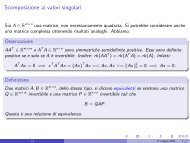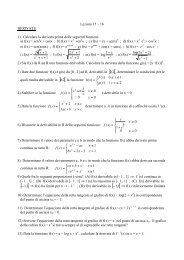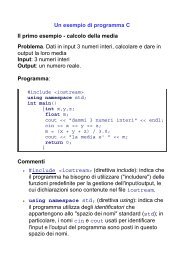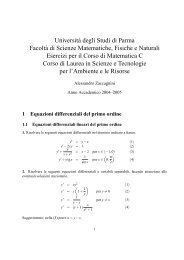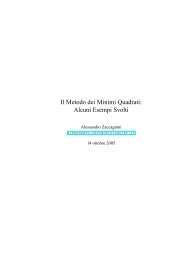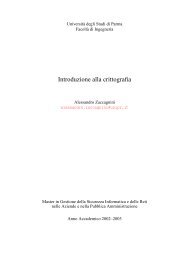ASPECTS OF IWASAWA THEORY OVER FUNCTION FIELDS 1 ...
ASPECTS OF IWASAWA THEORY OVER FUNCTION FIELDS 1 ...
ASPECTS OF IWASAWA THEORY OVER FUNCTION FIELDS 1 ...
You also want an ePaper? Increase the reach of your titles
YUMPU automatically turns print PDFs into web optimized ePapers that Google loves.
<strong>IWASAWA</strong> <strong>THEORY</strong> <strong>OVER</strong> <strong>FUNCTION</strong> <strong>FIELDS</strong> 225.4. Characteristic p L-functions. One of the most fascinating aspects of function fieldarithmetic is the existence, next to complex and p-adic L-functions, of their characteristic pavatars. For a thorough introduction the reader is referred to [18, Chapter 8]: here we justprovide a minimal background.Recall our fixed place ∞ and let C ∞ denote the completion of an algebraic closure of F ∞ .Already Carlitz had studied a characteristic p version of the Riemann zeta function, definedon N and taking values in C ∞ (we will say more about it in section 6.6). More recently Gosshad the intuition that, like complex and p-adic L-functions have as their natural domainsrespectively the complex and the p-adic (quasi-)characters of the Weil group, so one couldconsider C ∞ -valued characters. In particular, the analogue of the complex plane as domainfor the characteristic p L-functions is S ∞ := C ∗ ∞ × Z p , that can be seen as a group of C ∞ -valued homomorphisms on F ∗ ∞, just as for s ∈ C one defines x ↦→ x s on R + . The additivegroup Z embeds discretely in S ∞ . Similarly to the classical case, one can define L(ρ, s) forρ a compatible system of v-adic representation of G F (v varying among places different from∞) by Euler products converging on some “half-plane” of S ∞ .The theory of zeta values in characteristic p is still quite mysterious and at the moment wecan at best speculate that there are links with the Iwasawa theoretical questions consideredin this paper 4 . To the best of our knowledge, the main results available in this direction arethe following. Let F (p)/F be the extension obtained from the p-torsion of a Drinfeld-Hayesmodule (in the simplest case, F (p) is the F 1 we are going to introduce in section 6.1). Gossand Sinnott have studied the isotypic components of A(F (p)) and shown that they are nonzeroif and only if p divides certain characteristic p zeta values: see [18, Theorem 8.14.4] fora precise statement. Note that the proof given in [18], based on a comparison between thereductions of a p-adic and a characteristic p L-function respectively mod p and mod p ([18,Theorem 8.13.3]), makes use of Crew’s result. Okada [36] obtained a result of similar flavorfor the class group of the ring of “integers” of F (p) when F is the rational function field,and Shu [42] extended it to any F ; since Okada’s result is strictly related with the subject ofsection 6.6 below, we will say more about it there.6. Cyclotomy by the Carlitz module6.1. Setting. From now on we take F = F q (T ) and let ∞ be the usual place at infinity, so thatthe ring of elements regular outside ∞ is A := F q [T ]: this allows a number of simplifications,leaving intact the main aspects of the theory. The “cyclotomic” theory of function fields isobtained via Drinfeld-Hayes modules: in the setting of the rational function field the onlyone is the Carlitz module Φ: A → A{τ}, T ↦→ Φ T := T + τ (here τ denotes the operatorx ↦→ x q and, if R is an F p -algebra, R{τ} is the ring of skew polynomials with coefficients inR: multiplication in R{τ} is given by composition).We also fix a prime p ⊂ A and let π ∈ A be its monic generator. In order to underline thefact that A and its completion at p play the role of Z and Z p in the Drinfeld-Hayes cyclotomictheory, we will often use the alternative notation A p for the ring of local integers O p ⊂ F p .Let C p be the completion of an algebraic closure of F p .As usual, if I is an ideal of A, Φ[I] will denote the I-torsion of Φ (i.e., the common zeroesof all Φ a , a ∈ I). One checks immediately that if ι is the unique monic generator of I thenΦ ι (x) =∏(x − u) .u∈Φ[I]4 [Note added in proof] This field is in rapid evolution. After this paper was written, L. Taelman introducedsome important new ideas: see [L. Taelman, Special L-values of Drinfeld modules. To appear in Annals ofMath. 175 (2012), 369–391] and [L. Taelman, A Herbrand-Ribet theorem for function fields. To appear inInvent. Math., Online First DOI: 10.1007/s00222-011-0346-3].


